Abstract
A cell-free system that actively synthesizes collagen was prepared from L-929 fibroblasts. Chromatographic and electrophoretic techniques were used to demonstrate that the only collagenous products are pro α1 and pro α2 chains. The collagen synthesized by the cell-free system was also compared to the collagen extracted from the cells. The cellular collagen was composed of aggregates of pro-α chains, while no α chains were found. Procollagen peptidase activity could not be detected in the cells, and the activity present in the medium was low, comparable to that in dermatosparaxic cell cultures. These properties indicate that L-929 cells may be a model system for dermatosparaxis.
Keywords: procollagen peptidase, polysomes, protein synthesis
Full text
PDF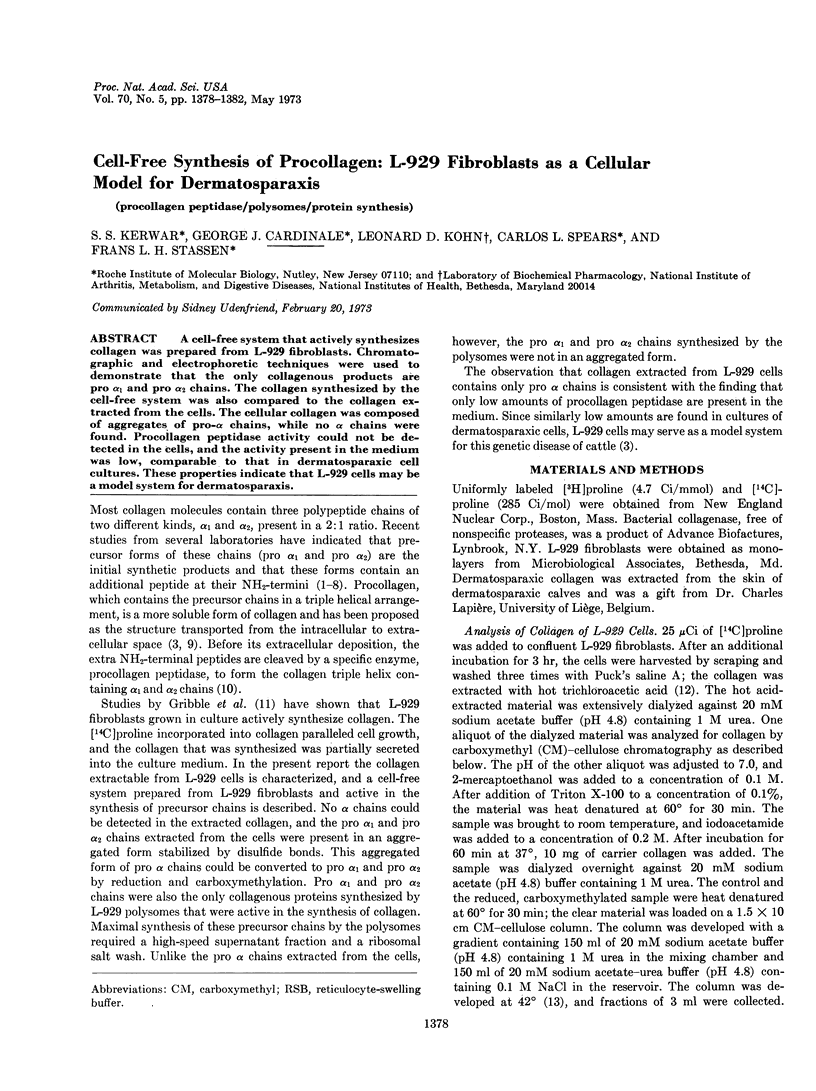
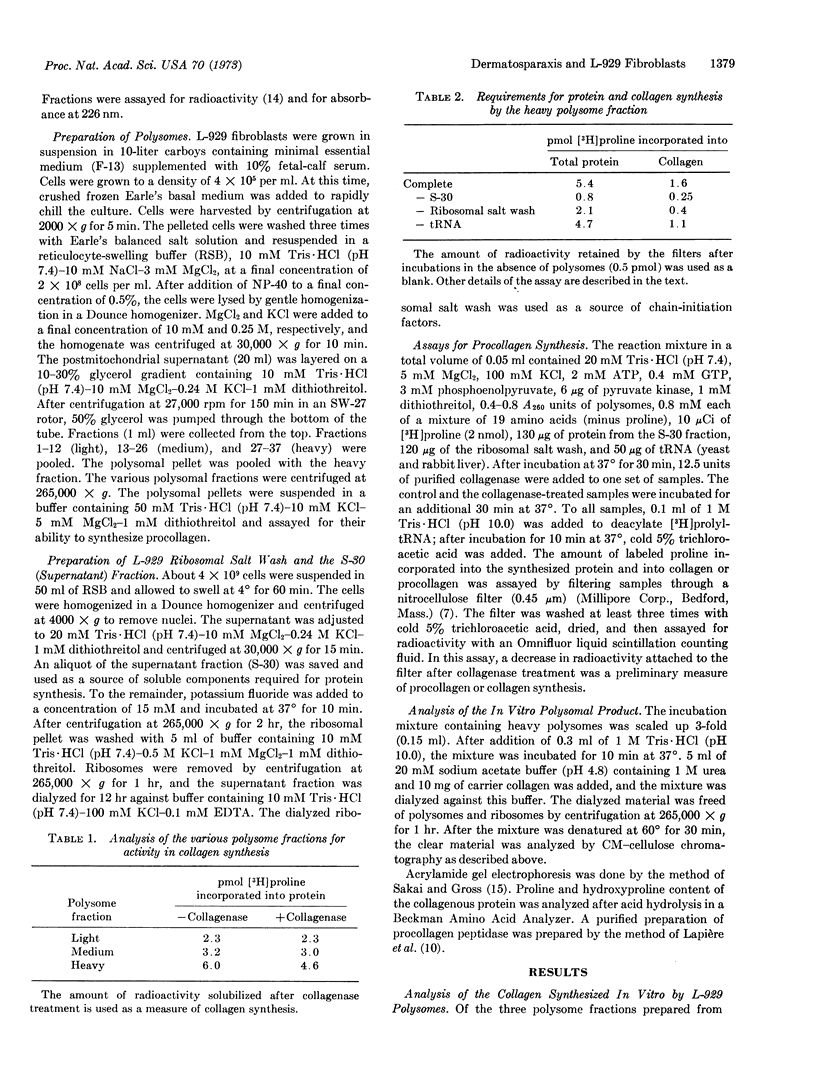
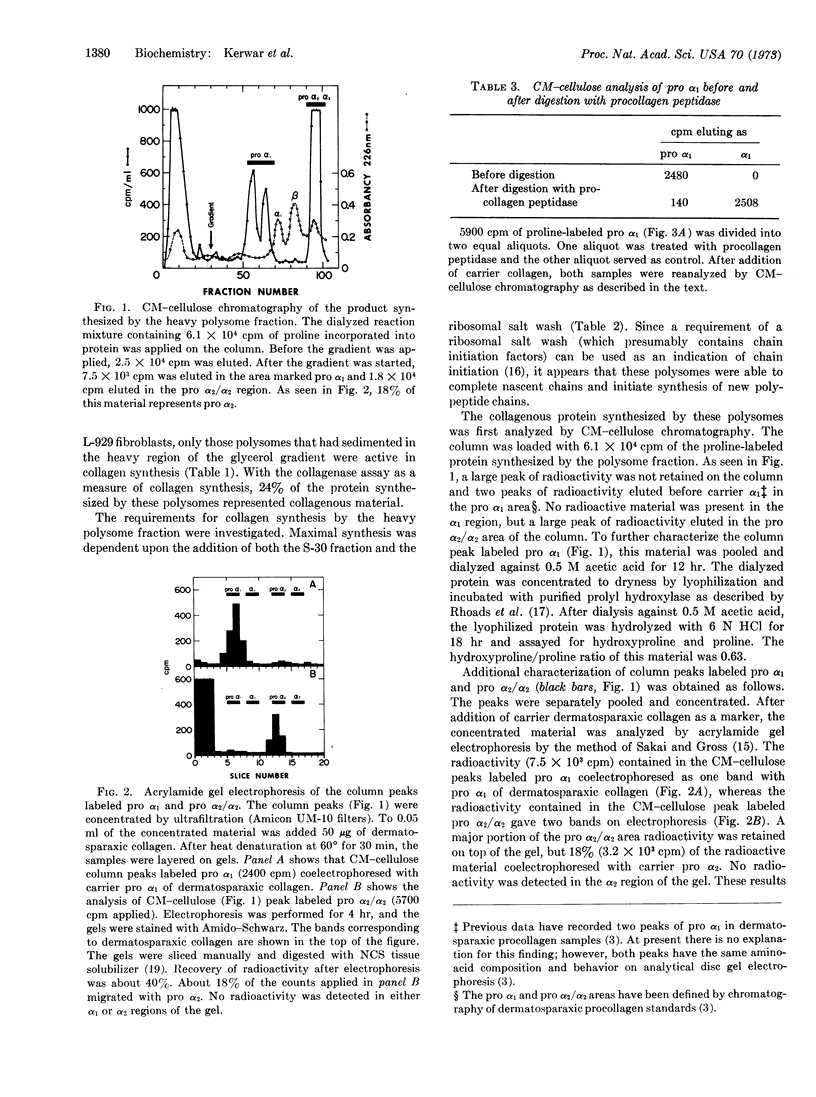
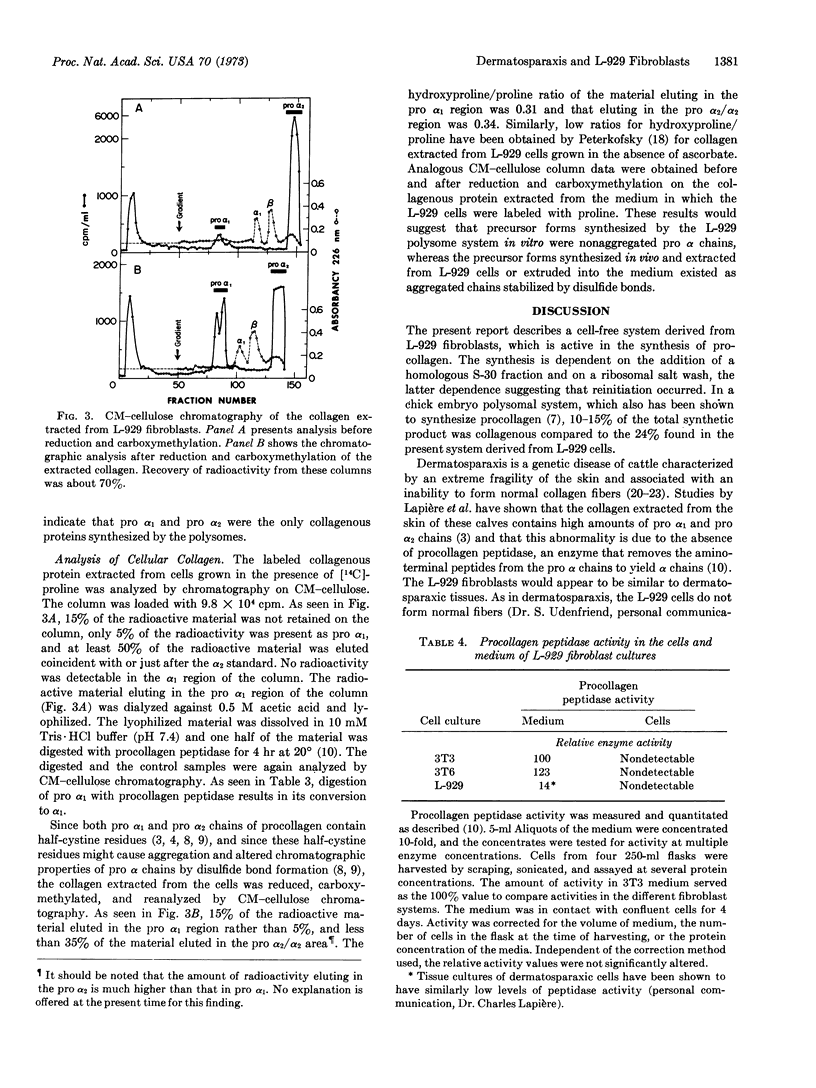
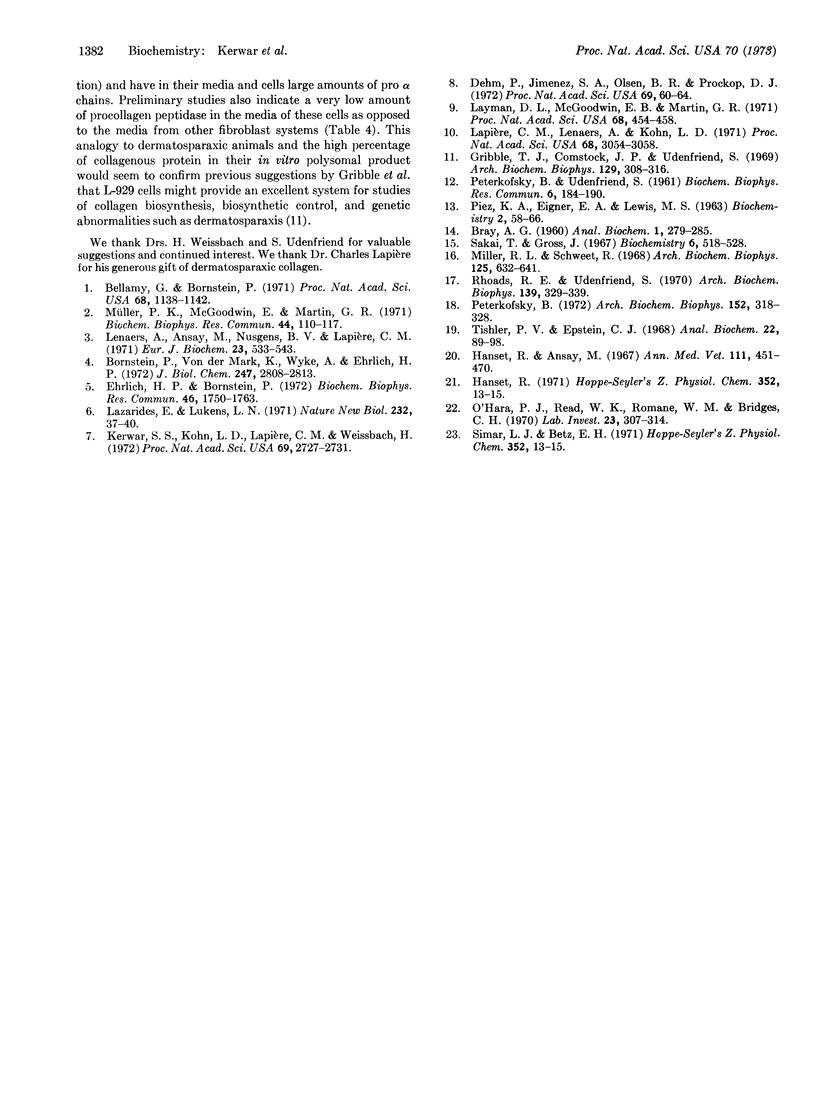
Selected References
These references are in PubMed. This may not be the complete list of references from this article.
- Bellamy G., Bornstein P. Evidence for procollagen, a biosynthetic precursors of collagen. Proc Natl Acad Sci U S A. 1971 Jun;68(6):1138–1142. doi: 10.1073/pnas.68.6.1138. [DOI] [PMC free article] [PubMed] [Google Scholar]
- Bornstein P., Von der Mark K., Wyke A. W., Ehrlich H. P., Monson J. M. Characterization of the pro- 1 chain of procollagen. J Biol Chem. 1972 May 10;247(9):2808–2813. [PubMed] [Google Scholar]
- Dehm P., Jimenez S. A., Olsen B. R., Prockop D. J. A transport form of collagen from embryonic tendon: electron microscopic demonstration of an NH 2 -terminal extension and evidence suggesting the presence of cystine in the molecule (chick embryo-tropocollagen-gel filtration). Proc Natl Acad Sci U S A. 1972 Jan;69(1):60–64. doi: 10.1073/pnas.69.1.60. [DOI] [PMC free article] [PubMed] [Google Scholar]
- Ehrlich H. P., Bornstein P. Further characterization of procollagen: the identification of a pro- 2 chain. Biochem Biophys Res Commun. 1972 Mar 10;46(5):1750–1756. doi: 10.1016/0006-291x(72)90046-0. [DOI] [PubMed] [Google Scholar]
- Gribble T. J., Comstock J. P., Udenfriend S. Collagen chain formation and peptidyl proline hydroxylation in monolayer tissue cultures of L-929 fibroblasts. Arch Biochem Biophys. 1969 Jan;129(1):308–316. doi: 10.1016/0003-9861(69)90180-5. [DOI] [PubMed] [Google Scholar]
- Kerwar S. S., Kohn L. D., Lapiere C. M., Weissbach H. In vitro synthesis of procollagen on polysomes. Proc Natl Acad Sci U S A. 1972 Sep;69(9):2727–2731. doi: 10.1073/pnas.69.9.2727. [DOI] [PMC free article] [PubMed] [Google Scholar]
- Lapière C. M., Lenaers A., Kohn L. D. Procollagen peptidase: an enzyme excising the coordination peptides of procollagen. Proc Natl Acad Sci U S A. 1971 Dec;68(12):3054–3058. doi: 10.1073/pnas.68.12.3054. [DOI] [PMC free article] [PubMed] [Google Scholar]
- Layman D. L., McGoodwin E. B., Martin G. R. The nature of the collagen synthesized by cultured human fibroblasts. Proc Natl Acad Sci U S A. 1971 Feb;68(2):454–458. doi: 10.1073/pnas.68.2.454. [DOI] [PMC free article] [PubMed] [Google Scholar]
- Lazarides E., Lukens L. N. Collagen synthesis on polysomes in vivo and in vitro. Nat New Biol. 1971 Jul 14;232(28):37–40. doi: 10.1038/newbio232037a0. [DOI] [PubMed] [Google Scholar]
- Lenaers A., Ansay M., Nusgens B. V., Lapière C. M. Collagen made of extended -chains, procollagen, in genetically-defective dermatosparaxic calves. Eur J Biochem. 1971 Dec 10;23(3):533–543. doi: 10.1111/j.1432-1033.1971.tb01651.x. [DOI] [PubMed] [Google Scholar]
- Miller R. L., Schweet R. Isolation of a protein fraction from reticulocyte ribosomes required for de novo synthesis of hemoglobin. Arch Biochem Biophys. 1968 May;125(2):632–646. doi: 10.1016/0003-9861(68)90622-x. [DOI] [PubMed] [Google Scholar]
- Müller P. K., McGoodwin E., Martin G. R. Studies on protocollagen: identification of a precursor of proto alpha 1. Biochem Biophys Res Commun. 1971 Jul 2;44(1):110–117. doi: 10.1016/s0006-291x(71)80165-1. [DOI] [PubMed] [Google Scholar]
- O'Hara P. J., Read W. K., Romane W. M., Bridges C. H. A collagenous tissue dysplasia of calves. Lab Invest. 1970 Sep;23(3):307–314. [PubMed] [Google Scholar]
- PETERKOFSKY B., UDENFRIEND S. Conversion of proline-C14 to peptide-bound hydroxyproline-C14 in a cell-free system from chick embryo. Biochem Biophys Res Commun. 1961 Nov 20;6:184–190. doi: 10.1016/0006-291x(61)90126-7. [DOI] [PubMed] [Google Scholar]
- Peterkofsky B. The effect of ascorbic acid on collagen polypeptide synthesis and proline hydroxylation during the growth of cultured fibroblasts. Arch Biochem Biophys. 1972 Sep;152(1):318–328. doi: 10.1016/0003-9861(72)90221-4. [DOI] [PubMed] [Google Scholar]
- Rhoads R. E., Udenfriend S. Purification and properties of collagen proline hydroxylase from newborn rat skin. Arch Biochem Biophys. 1970 Aug;139(2):329–339. doi: 10.1016/0003-9861(70)90485-6. [DOI] [PubMed] [Google Scholar]
- Sakai T., Gross J. Some properties of the products of reaction of tadpole collagenase with collagen. Biochemistry. 1967 Feb;6(2):518–528. doi: 10.1021/bi00854a021. [DOI] [PubMed] [Google Scholar]
- Tishler P. V., Epstein C. J. A convenient method of preparing polyacrylamide gels for liquid scintillation spectrometry. Anal Biochem. 1968 Jan;22(1):89–98. doi: 10.1016/0003-2697(68)90262-5. [DOI] [PubMed] [Google Scholar]


